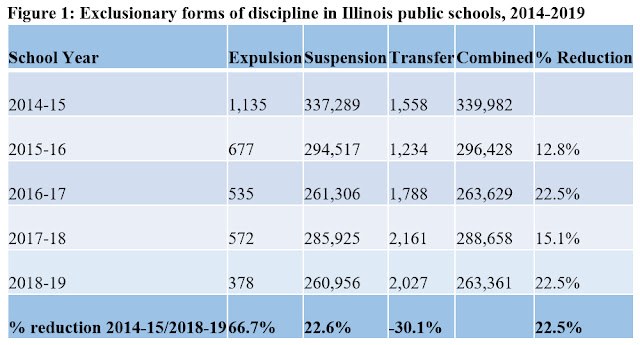Exclusionary Discipline Decreasing in Illinois Schools, but Racial Disparities Persist
by Shawn P. Healy, PhD, Democracy Program Director
Last year, I assessed the impact of a series of recent laws passed in Illinois to limit exclusionary discipline and public schools and instead employ restorative practices. Recall that the School Code now:
- Requires districts to report exclusionary discipline measures (expulsions, suspensions, and transfers to alternative schools) by student subgroups, including race and ethnicity;
- Eliminates broad-based zero tolerance policies in favor of restorative practices;
- And prohibits preschool expulsion from state-funded facilities.
Such progress is to be celebrated, but it comes with a caveat: racial disproportionality in punishment remains stagnant, with the state’s Black students bearing the brunt of exclusionary discipline. In 2014-2015, Black students represented 44.9% of those expelled, suspended, or transferred, despite composing only 17.5% of the state’s K-12 student population. This equates to a disproportionality factor of 2.6.
Fast forward to 2018-2019, Black students composed 41.3% of combined exclusionary discipline targets, but only 16.7% of the student population. The rate of disproportionality fell only a tenth of a percentage point to 2.5, a rate 4.2 times that of white students (see Figure 2 below).
Students identifying with two or more races are also more likely to face forms of exclusionary discipline than their percentage of the population would predict, and the rate for Latinx students is 50% higher than whites.
These alarming findings provide further evidence that public policies present opportunities more than predict outcomes. Implementation, or lack thereof, is where policies succeed or fail. To this end, the McCormick Foundation, in partnership with our grantees, is exploring how a gallant implementation effort led by the Transforming School Discipline Collaborative, can be better resourced.
We will detail these interventions in full later this month. In the interim, please review the presentation I delivered last Friday at the DuPage County Social Studies Conference with Dean David Schumacher of Metea Valley High School titled “Restorative Justice Implementation.” I provided an overview of existing statutes, progress to date in implementing them, and further interventions necessary to reach their letter and spirit, while David highlighted how his school is deploying restorative practices.






Comments
Post a Comment